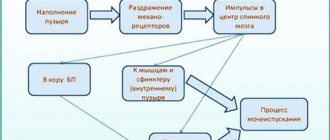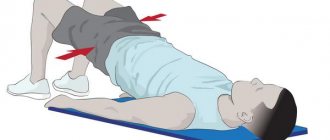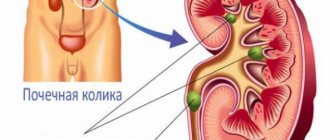Causes of piriformis syndrome
The cause of the syndrome can be various pathological changes in the piriformis muscle - damage, inflammation, fibrotic changes, spasms and an increase in muscle volume. Sometimes intramuscular injections lead to the disease, causing abscesses and the formation of infiltrate.
The main etiological factors of SHM: • Trauma. Piriformis syndrome can be associated with muscle overextension, muscle fiber tears, and fibrosis. In the latter case, the piriformis muscle shortens and thickens. • Post-traumatic hematomas and inflammatory processes – myositis, sacroiliitis, cystitis, prostatitis, endometriosis, prostate adenoma. • Vertebrogenic pathologies. This group includes spondyloarthrosis, osteochondrosis, intervertebral hernia in the lumbar region, spinal and vertebral tumors. As a result of irritation of the fibers of the sacral plexus and spinal roots, a reflex spasm occurs. • Muscle overload associated with prolonged forced position of the lumbopelvic segment. Increased loads occur in cases where, with radiculopathy, the patient tries to take an antalgic position (body position in which pain is minimal). Various sports can cause impairment, including weightlifting and running. • Oncological diseases of the tissues of the sacral region and proximal femur. They cause anatomical changes in structures. Neoplasia can cause spasm of the piriformis muscle. • Asymmetry, which occurs with shortened legs or scoliosis. Sometimes a hip amputation can put the muscle into a permanent spastic state that causes phantom pain.
Signs of Piriformis Syndrome
The most common symptoms of piriformis syndrome are:
- soreness in the buttocks, usually only on one side;
- the pain goes down from the buttock down the back of the leg.
Some people with piriformis syndrome think the pain is caused by an injury to the hamstring. The main symptom of piriformis syndrome is pain in the popliteal fossa, but pain may be in the thigh or buttocks.
Piriformis syndrome can occur suddenly, usually after an injury, or develop gradually over several months.
Mechanism of development of the syndrome
The piriformis muscle (Musculus piriformis) is attached with its narrow end to the greater trochanter of the femur, and its wide end to the sacrum. It is involved in external rotation and during internal hip abduction, passing through the greater sciatic foramen. The inferior gluteal, sciatic, pudendal and posterior cutaneous nerves, gluteal arteries and veins also pass through this opening. This makes piriformis syndrome a disease that requires a comprehensive systemic approach. Persistent contraction of the piriformis muscle reduces the size of the infrapiriformis foramen. This leads to compression of passing vessels and nerves, primarily the sciatic one. Compression impairs the blood supply to the nerve trunk, being an additional pathogenetic component of sciatica.
Osteopathy offers an alternative to classical medicine and complements it, expanding the understanding of the disease. Osteopaths at the Quality of Life clinic can offer a solution to the problem with the piriformis muscle. Painful sensations that do not have a clear localization often arise as a result of spasm of the muscular-ligamentous apparatus, the causes of which are very diverse. When muscles contract, they move internal organs from their place, disrupt their function and cause pain. This is due to tension, compression and twisting of nerve, blood and lymphatic communications.
Causes of Piriformis Syndrome
Reasons may include:
- injuries such as a fall, blow, or car accident;
- excessive exercise or excessive stretching;
- sedentary lifestyle;
- weakness of the gluteal muscles;
- muscle tension and excess weight due to pregnancy.
Many doctors diagnose piriformis syndrome based on symptoms alone. Only two tests can help make the correct diagnosis:
MR neurography
. This is a type of magnetic resonance imaging (MRI) that looks for inflammation of the nerve.
Survey
- The doctor performs hip flexion, adduction, and internal rotation to stretch the piriformis muscle and compress the sciatic nerve. The doctor measures the delay in signals in the sciatic nerve due to compression by the piriformis muscle.
Classification of piriformis syndrome
Piriformis syndrome has only two forms: • Primary, which occurs due to direct damage. Primary SHM occurs as a result of injuries, myositis, and excess stress. • Secondary. This is the result of prolonged pathological impulses from the sacral or lumbar spine, sacroiliac joint, and small pelvis. Secondary SHM is formed by neoplasms in the spine, pelvic organs and hip joint.
Primary piriformis syndrome is caused by anatomical factors, variations of which may be related to separation of the piriformis muscle or sciatic nerve, as well as abnormal development of this nerve. Among patients with this disorder, less than 15% of cases are due to primary causes. Conventional medicine does not have precise data regarding the prevalence of FMS and does not offer evidence linking the disorder to sciatic nerve abnormalities or other types of sciatica.
The occurrence of secondary piriformis muscle syndrome is associated with the action of aggravating factors, including macro- and microtrauma, long-term accumulation of ischemia and the existence of local ischemia. • The development of piriformis syndrome most often (in about half of all cases) is promoted by trauma to the buttocks, which inflames the soft tissues and causes muscle spasm. This eventually causes compression of the nerve. • Spasms may be associated with muscle shortening caused by changes in leg and lumbosacral biomechanics. This causes compression or irritation of the sciatic nerve. When the piriformis muscle stops contracting normally, it can cause a variety of symptoms in the sciatic nerve area, including pain in the gluteal region and/or the hamstrings, calf, and lateral foot. Microtrauma can be caused by overuse, such as long walking or long distance running, as well as direct compression.
Osteopaths work with the root cause of the disorder, eliminating the problems that caused the development of BMS.
What is piriformis syndrome?
The piriformis muscle has the form of a flat isosceles triangle, the base of which originates from the outer surface of the sacrum, lateral to the openings between the II and IV sacral pelvic openings. This muscle can compress the sciatic nerve, which is the largest nerve in the body. It runs from the lower spine down the leg. Compression of the sciatic nerve can lead to pain, tingling or numbness anywhere from the hip to the lower leg.
The role of spasms in the pathogenesis of piriformis syndrome
Spasm is a protective reaction of the body in the form of sustained tension and muscle contraction. It occurs as a response to threats associated with physical influences (blows, pain) or mental stress (fear, anxiety). When the threat passes, the tension gradually subsides, the tone of the muscles and ligaments is restored. However, this does not always happen.
If the muscle is constantly tense, this leads to compression of the vessels of the circulatory and lymphatic systems, because the tissues do not receive the required amount of oxygen and nutrients. As a result, their hypoxia develops and local immunity decreases, which leads to chronic inflammation. With constant stress over several weeks, fibrosis develops - a hardening of the tissue, which is usually accompanied by severe pain. But even at this stage the situation can still be corrected: the osteopath, having worked with the genitourinary system, the lumbopelvic region, and the dura mater, will eliminate spasms of muscles and ligaments and return them to their original tone. However, with very long spasms (more than a year), irreversible tissue scarring processes begin, resulting in ossification (calcification) of the muscle or ligament. Considering that spasm can be caused even by a visit to the gynecologist, not to mention childbirth or abortion, the scale of this problem in women is amazing.
The role of this muscle in ensuring the normal functioning of a woman’s body is great. Spasms and fibrotic phenomena often cause dull aching pain of different localization: • sacral; • lumbar; • gluteal.
They often intensify during squatting. In addition, spasms can be an additional risk factor for the development of a number of other pathologies - in particular, hemorrhoids and arthrosis of the hip joint.
Muscle spasms and fibrosis can also cause difficulties during labor. This is due to the fact that the birth canal fits tightly to the sacrum, so the contractions of the Musculus piriformis play an important role in the birth of the child, pushing and turning the fetal head. If the muscle is fibrotic, the fetal head stands in one position for a long time. This is fraught with damage to soft tissues and a number of other complications.
On the other hand, Musculus piriformis itself is injured during childbirth, which can cause fibrosis in the postpartum period. Therefore, every woman should visit an osteopath before and after childbirth. Voltage is easily determined during examination. Osteopathic techniques gently and painlessly eliminate spasm, and exercise therapy doctors will teach the patient the correct technique of exercises to strengthen the hips, back, buttocks and abs, and normalize the position of the lumbopelvic region.
We have considered only a small part of the situations and problems associated with internal spasms of the piriformis muscle. Each organ is supported by several muscles and ligaments, each of which, in turn, can go into spasm.
Moreover, the consequences are far from limited to pain, but can be much more serious. For example, forced displacement of the uterus during an abortion causes deep spasms of all the ligaments that attach the organ to the skeleton.
Since it does not return to its original anatomical position, sometimes twisting of blood vessels and nerves occurs. In case of a new pregnancy, this can lead to fetal hypoxia and developmental delay.
Osteopathic correction is a soft and delicate effect not only on the source of pain, but also on the true causes of the syndrome. A competent osteopath will help set the body up for self-healing, rehabilitate muscles and internal organs.
Treatment of piriformis syndrome
Performing exercises and stretches can reduce the severity of muscle spasms and relieve muscle tension.
People with piriformis syndrome can try the following exercises:
Lying on your back with your legs extended. Raise your affected leg toward your chest, holding your knee and ankle. Pull your knee and ankle in the opposite direction to stretch the muscle.
Lying on your back with your legs extended. Lift your affected leg and place it on the outside of the opposite knee. Extend your leg across your body using your arm.
Perform each exercise for 30 seconds and repeat three to five times.
In addition to stretching, other treatment methods may be used.
Alternating hot and cold compresses can improve blood flow and is effective for pain relief.
Walking can relieve muscle tension and prevent cramps.
For pain, non-steroidal anti-inflammatory drugs (NSAIDs) can be used.
Rest is recommended in the first days after injury.
Massaging the painful area as well as surrounding muscles. Tension in one muscle can cause tension in another, so massaging the thighs and buttocks can be quite beneficial.
Symptoms
In approximately 70%, the gluteal-sacral area is affected first. The pain is constant, often nagging and aching. They intensify during walking, squats, and hip adduction. To reduce discomfort, the patient has to spread his legs to the sides. Over time, pain along the sciatic nerve - sciatica - is added to the symptoms. Shooting marks appear running from the foot to the buttocks. In the area where the SGM is located, pain sensitivity decreases and a burning sensation occurs.
Hypotonia of the muscles of the foot and lower leg gradually develops. With total compression of nerve fibers, “dangling foot” may develop. The main manifestations include intermittent claudication, which is a consequence of vascular compression. The same disorder leads to a decrease in leg temperature, pale skin and numbness of the fingers.
Possible risks and complications of piriformis syndrome
Constant debilitating pain reduces the patient's ability to work. It can lead to: • emotional lability; • insomnia; • increased fatigue.
Peripheral paresis of the leg and foot caused by the syndrome develop muscle atrophy. With prolonged progression of the syndrome, the changes become irreversible. Persistent paresis leads to disability. Secondary spasm of the pelvic floor muscles is also possible. This causes discomfort when urinating, dyspareunia (pain during sexual intercourse) in women.
Osteopathic treatment
Osteopathic treatment does not just act on the sore spot, but treats the entire body as a whole; the doctor “listens to the body with his hands.” All organs and systems constantly pulsate, and spasms and tensions distort the picture characteristic of the body of a healthy person. The magnitude of these pulsations is insignificant, but is accessible to the sensitive hands of an osteopath.
Having examined these micropulsations, the doctor determines the cause of the syndrome and eliminates muscle tension. Muscle tissues and ligaments are stretched and relaxed, and the doctor uses gentle movements to move organs and tissues to return them to their normal anatomical position.
Osteopathic correction of the bones, muscles and ligaments of the pelvis, as well as the lumbosacral spine, plays a special role in osteopathic treatment. Soft muscular-fascial relaxation of the Musculus piriformis quickly restores the normal state and eliminates the cause of the syndrome - compression of the sciatic nerve and blood vessels. In especially severe cases, the treatment program is supplemented with drug blockade of the brain.
Exercise therapy in the treatment program
After the acute pain syndrome is relieved, the results of osteopathic treatment are consolidated with the help of physical therapy. This allows you to avoid re-exacerbation of the syndrome. Exercises are performed under the guidance of an instructor. The program includes the implementation of special complexes aimed at strengthening: • the muscular corset of the lower back; • buttocks; • lower extremities. Work is also carried out with other parts of the musculoskeletal system.
Treatment of BMS is not aimed at relieving symptoms, but at eliminating the root cause of the syndrome. Therefore, any pain relief without treating the provoking factor is pointless. The exercises that are prescribed to patients are aimed at fully relaxing the muscular-ligamentous system, as well as activating antagonists in the movement of the lumbosacral region









